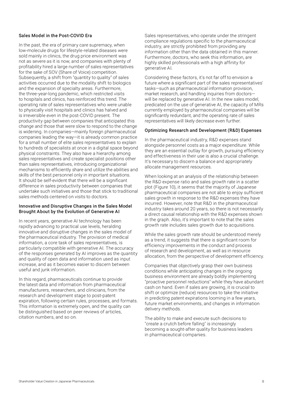
8
Shareholder Value Creation in Japanese Pharmaceuticals
Sales Model in the Post-COVID Era
In the past, the era of primary care supremacy, when
low-molecule drugs for lifestyle-related diseases were
sold mainly in clinics, the drug price environment was
not as severe as it is now, and companies with plenty of
profitability hired a large number of sales representatives
for the sake of SOV (Share of Voice) competition.
Subsequently, a shift from "quantity to quality" of sales
activities occurred due to the modality shift to biologics
and the expansion of specialty areas. Furthermore,
the three-year-long pandemic, which restricted visits
to hospitals and clinics, has reinforced this trend. The
operating rate of sales representatives who were unable
to physically visit hospitals and clinics has halved and
is irreversible even in the post-COVID present. The
productivity gap between companies that anticipated this
change and those that were slow to respond to the change
is widening. In companies-mainly foreign pharmaceutical
companies leading the way-it is already common practice
for a small number of elite sales representatives to explain
to hundreds of specialists at once in a digital space beyond
physical constraints. They also have a hierarchy among
sales representatives and create specialist positions other
than sales representatives, introducing organizational
mechanisms to efficiently share and utilize the abilities and
skills of the best personnel only in important situations.
It should be self-evident that there will be a significant
difference in sales productivity between companies that
undertake such initiatives and those that stick to traditional
sales methods centered on visits to doctors.
Innovative and Disruptive Changes in the Sales Model
Brought About by the Evolution of Generative AI
In recent years, generative AI technology has been
rapidly advancing to practical use levels, heralding
innovative and disruptive changes in the sales model of
the pharmaceutical industry. The provision of medical
information, a core task of sales representatives, is
particularly compatible with generative AI. The accuracy
of the responses generated by AI improves as the quantity
and quality of open data and information used as input
increase, and as it becomes easier to discern between
useful and junk information.
In this regard, pharmaceuticals continue to provide
the latest data and information from pharmaceutical
manufacturers, researchers, and clinicians, from the
research and development stage to post-patent
expiration, following certain rules, processes, and formats.
This information is extremely open, and the quality can
be distinguished based on peer reviews of articles,
citation numbers, and so on.
Sales representatives, who operate under the stringent
compliance regulations specific to the pharmaceutical
industry, are strictly prohibited from providing any
information other than the data obtained in this manner.
Furthermore, doctors, who seek this information, are
highly skilled professionals with a high affinity for
generative AI.
Considering these factors, it's not far off to envision a
future where a significant part of the sales representatives'
tasks-such as pharmaceutical information provision,
market research, and handling inquiries from doctors-
will be replaced by generative AI. In the new sales model,
predicated on the use of generative AI, the capacity of MRs
currently employed by pharmaceutical companies will be
significantly redundant, and the operating rate of sales
representatives will likely decrease even further.
Optimizing Research and Development (R&D) Expenses
In the pharmaceutical industry, R&D expenses stand
alongside personnel costs as a major expenditure. While
they are an essential outlay for growth, pursuing efficiency
and effectiveness in their use is also a crucial challenge.
It's necessary to discern a balance and appropriately
allocate management resources.
When looking at an analysis of the relationship between
the R&D expense ratio and sales growth rate in a scatter
plot (Figure 10), it seems that the majority of Japanese
pharmaceutical companies are not able to enjoy sufficient
sales growth in response to the R&D expenses they have
incurred. However, note that R&D in the pharmaceutical
industry takes around 20 years, so there is not necessarily
a direct causal relationship with the R&D expenses shown
in the graph. Also, it's important to note that the sales
growth rate includes sales growth due to acquisitions.
While the sales growth rate should be understood merely
as a trend, it suggests that there is significant room for
efficiency improvements in the conduct and process
of research and development, as well as in resource
allocation, from the perspective of development efficiency.
Companies that objectively grasp their own business
conditions while anticipating changes in the ongoing
business environment are already boldly implementing
"proactive personnel reductions" while they have abundant
cash on hand. Even if sales are growing, it is crucial to
shift or optimize (reduce) resources to take the initiative
in predicting patent expirations looming in a few years,
future market environments, and changes in information
delivery methods.
The ability to make and execute such decisions to
"create a crutch before falling" is increasingly
becoming a sought-after quality for business leaders
in pharmaceutical companies.